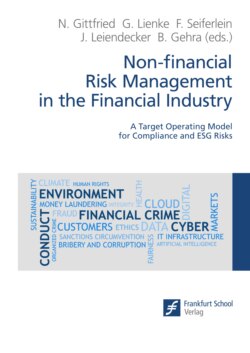Читать книгу Non-financial Risk Management in the Financial Industry - Группа авторов - Страница 14
На сайте Литреса книга снята с продажи.
1.8 Putting conduct and ethics at the centre of sustainable non-financial risk management
ОглавлениеRecent scandals in the corporate world have demonstrated that a lack of ethical values is often at the root of corporate misconduct. Hence, the role of conduct and ethics cannot be emphasised enough.
Chapter 13 describes the subtle interplay between ethics, conduct and integrity in the context of the financial industry, and it outlines the implications for managers who must learn to navigate today’s complex regulatory landscape. Most business ethicists agree that, in general, financial institutions’ ethical taxonomies could be divided into two categories: conduct/compliance-based ethics and integrity-based ethics. While the former constitute principles and codes born from government regulations, the latter are based on the establishment of core principles to which all employees are asked to adhere to and govern themselves accordingly. Organisations that combine both conduct-/compliance-based with integrity-based ethics could significantly mitigate conduct risk (market, client and employee conduct risk). Three major areas emerge as key focal points for regulatory oversight: expansion of the circle of stakeholders, elimination of “rolling bad apples” and greater cross-border collaborations. Supervisory bodies expect companies to behave ethically and maintain a strong focus on good conduct, not just towards their customers but towards all stakeholders. Technology is playing an increasingly bigger role in the support of its monitoring and implementation.
Chapter 14 examines two key trends in the regulation of conduct risk: Treating Customers Fairly (TFC) and the Senior Managers and Certification Regime (SM&CR). The idea of TFC as the standard for good conduct has made its way into financial regulatory frameworks all across the globe. Another overarching global trend has been the shift away from a case-by-case approach towards treating conduct risk as a systemic phenomenon. As such, recent regulations have focused on extending individual liabilities through elaborate SM&CRs. Conduct risk figures prominently on the ESG agenda for mainly two reasons: it is a key feature of a firm’s governance framework and directly impacted by sustainability risks, and its occurrence is estimated to be on the rise as ESG investing brings forth novel opportunities and new decision-making.
To manage conduct risk, the development and implementation of an effective conduct risk framework is required, reflecting and tailored to a firm’s culture, business environment and regulatory landscape, while it is also implemented through appropriate systems. Three key principles, however, should stand at the core of every framework: standardised metrics, customer centricity and clear definitions. Unfortunately, there is no one-size-fits-all approach. Each financial institution must remain vigilant about new conduct risks and develop its own approach based on its own exposures, activities and overall strategies.
